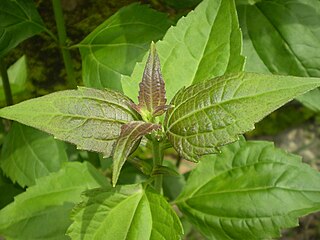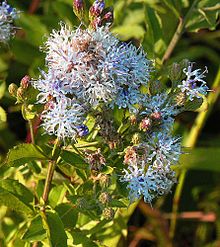
Lactuca, commonly known as lettuce, is a genus of flowering plants in the family Asteraceae. The genus includes at least 50 species, distributed worldwide, but mainly in temperate Eurasia.

Vernonia galamensis is a plant in the sunflower family, known for its use as an oilseed. This species, often called ironweed, is the largest source of vernonia oil, which is rich in a useful epoxy fatty acid called vernolic acid and is used to make plastics, rubbery coatings, and drying agents. Use of this oil as a replacement for traditional plasticizers and binders in the production of paints and PVC shows promise as a method of reducing smog pollution.

Verbesina, many species of which have crownbeard as part of their common names, is a genus of flowering plants, in the family Asteraceae. It is a large genus of about 350 species.

Chromolaena odorata is a tropical and subtropical species of flowering shrub in the family Asteraceae. It is native to the Americas, from Florida and Texas in the United States south through Mexico and the Caribbean to South America. It has been introduced to tropical Asia, West Africa, and parts of Australia.

Brachylaena huillensis is a species of flowering plant in the family Asteraceae. It is found in the montane forests of Angola, Kenya, Mozambique, South Africa, Tanzania, Uganda, and Zimbabwe. With a height of up to 131 feet ( it is, with Vernonia arborea candidates for the tallest of all Composites and at up to 60 centimeters also the most massive.

Vernonieae is a tribe of about 1300 species of plants in the aster family. They are mostly found in the tropics and warmer temperate areas, both in the Americas and the Old World. They are mostly herbaceous plants or shrubs, although there is at least one tree species, Vernonia arborea.

Vernonia amygdalina, a member of the daisy family, is a small shrub that grows in tropical Africa. V. amygdalina typically grows to a height of 2–5 m (6.6–16.4 ft). The leaves are elliptical and up to 20 cm (7.9 in) long. Its bark is rough.

Distichlis is a genus of American and Australian plants in the grass family. Plants in this genus are dioecious, have rhizomes or stolons, and have conspicuously distichous leaves.

Stokesia is a monotypic genus of flowering plants in the daisy family, Asteraceae, containing the single species Stokesia laevis. Common names include Stokes' aster and stokesia. The species is native to the southeastern United States.

Solidago gigantea is a North American plant species in the family Asteraceae. Its common names include tall goldenrod and giant goldenrod, among others.

Townsendia condensata is a species of flowering plant in the family Asteraceae known by the common names cushion Townsend daisy and cushion townsendia. It is native to North America where it is known from many scattered occurrences in the mountains of the western United States and Alberta in Canada. It is mainly limited to the alpine climates of high mountain peaks, where it grows in meadows, tundra, and barren, rocky talus. It grows alongside other alpine plants such as Eriogonum androsaceum.
Gutierrezia texana is a North American species of flowering plant in the family Asteraceae known by the common name Texas snakeweed. It is native to the south-central United States and northern Mexico as far south as Guanajuato and Hidalgo.

Vernonanthura is a genus of Neotropical plants in the tribe Vernonieae within the family Asteraceae.
Strobocalyx is a genus of Asian, African, Pacific Island, and South American plants in the tribe Vernonieae within the family Asteraceae. It is sometimes regarded as part of the genus Vernonia.

Sphaerocoris annulus, common names Picasso bug or Zulu hud bug, is a species of shield-backed bugs of the family Scutelleridae.

Vernonia texana, commonly called Texas ironweed, is a species of flowering plant in the aster family (Asteraceae). It is native eastern to North America, where it is found primarily in the South Central region of the United States. Its natural habitat is in open sandy woodlands.
Vernonia schweinfurthii is a species of plant in the family Asteraceae. It is native to Angola, Burundi, Cameroon, Central African Repu, Ivory Coast, Malawi, Nigeria, Rwanda, Sudan, Zambia. One subspecies is recognized: Vernonia schweinfurthii var. bukamaensis.
Brenandendron frondosum is a plant in the family Asteraceae, native to tropical Africa.
Orbivestus bamendae is a plant in the family Asteraceae.



















